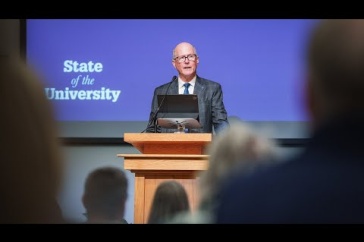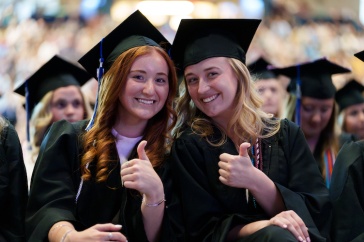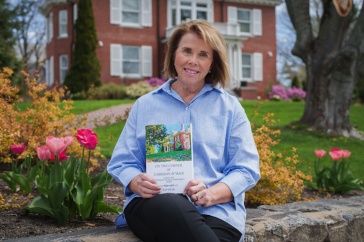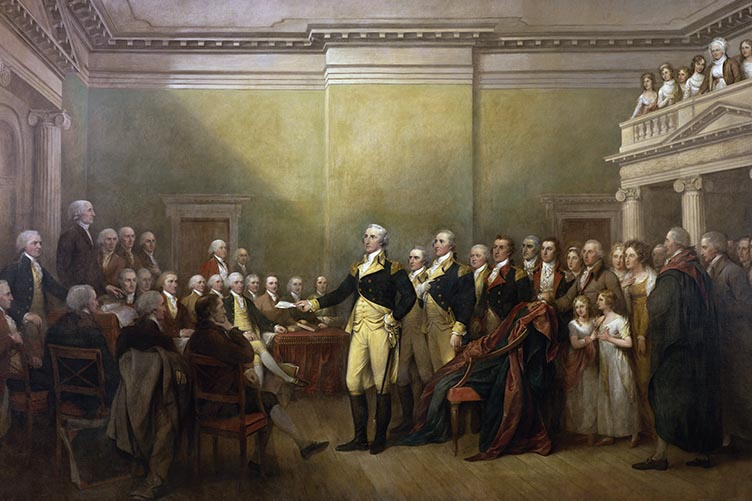
John Trumbull, General George Washington resigning his commission (1822-1824), U.S. Capitol, Washington, D.C.
Last spring, as I have done almost every year for the last two decades, I spent the semester teaching the early American survey. Because the course satisfies one of UNH’s discovery, or general education, requirements, the lecture hall is always full of engineers, nursing students, would-be veterinarians, entrepreneurs in training from the business school, and, of course, lots and lots of psychology and communication students. Only a few of the class are usually history majors. Although a handful will change their minds by semester’s end, I know that for most students, this is going to be their only college-level history class — and in all likelihood their last academic exposure to the discipline.
For this reason, of the classes that I regularly offer, the History of Early America is my hands-down favorite. To the uninitiated, the course might appear to be only tangentially related to the other, scholarly part of my job description, which, for me, means conducting research and writing books and articles about the American Revolution. Yet there is quite a lot of overlap. One place that overlap emerges is in my refusal when I teach the survey to follow the chronology favored by practically every textbook on the market. To judge from the chapter structure of the book that I assign my students, the authors would have me cover the first three (give or take) centuries of early American history before March break, then spend the second half on the 60 years between the rise of Andrew Jackson and the Civil War. Instead, I place the Revolution at the course’s midpoint, dividing the two halves at 1776. By spending an additional week or two on the colonial period, I find that students have an easier time grasping what was transformational about the American Revolution, and what was not. Making the Revolution the course’s centerpiece also underscores what a pivotal moment the nation’s founding was. When it comes to the early American survey, I’ve never been tempted to teach it any other way.
Another area where my teaching and scholarship overlap is the message that I hope students in the course will take away. As every history teacher knows, one of the central challenges with any survey is negotiating the gap between how professional historians understand historical events and how those events are perceived in the media and popular press. In courses on the American Revolution, that gap often manifests itself as a tension between “the popular narrative of democracy’s heroic birth,” as a colleague who teaches at another college has written, and accounts that acknowledge less flattering parts of the early republic’s past, including its “imperial and racist” history. Of late, though, I worry that even heroic stories are not as popular or familiar as we might like to think. Three years ago, in a YouTube video that has scored more than 2 million views, PoliTech, a student-run group at Texas Tech, quizzed fellow students on the basic facts of American history: Who won the Civil War? Who did we gain our independence from? And when? With one or two exceptions, the answers were variations of “I have no idea” or “I couldn’t tell you.” Heavily edited and produced for comic effect, the video is obviously not a scientific study, and it does a disservice to the many students everywhere — including in my own classes — who do know their history, but it captures an unwelcome truth: In an age of fake news and alternative facts, the history that we convey to our students will, in more cases than we may care to admit, be the sum total of the history that they know.

Although I certainly don’t claim to have all the answers, that reality increasingly shapes how I think about the Revolution both in my teaching and my scholarship. For starters, I find that some heroic narratives are worth telling, and even celebrating. In my lecture on the Revolutionary War, I have long included the story of George Washington’s (self-consciously heroic) response to the Newburgh Conspiracy, a planned coup by disgruntled (and unpaid) Continental Army officers, possibly with encouragement from some politicians, that Washington forestalled with an emotional appeal to his officers to support the supremacy of the United States Congress. We have a sizable ROTC program at UNH. The example of military subordination to civil authority that Washington set in 1783 is one that every student considering a military career today ought to hear.
I also include the heroism of people who don’t usually show up in popular narratives. Partly to balance the attention to his former master, students love hearing about Harry Washington, and how the onetime slave of the nation’s first president gained his freedom by joining the British army during the Revolutionary War, then immigrated to Sierra Leone, where he built a farm using techniques he had learned at Mount Vernon. Democratic heroism can take many forms.
More than anything else, though, I ask students to accept that despite the vast differences between then and now, early Americans, regardless of their race, gender or creed, were in one very import- ant respect just like Americans today: They were complicated, multifaceted human beings, who routinely thought and behaved in inconsistent, often contradictory ways. For the truth of that statement, take the white Maryland Loyalist and adventurer William Augustus Bowles, one of the American Revolution’s more colorful figures. The son of English parents, Bowles was adopted by Creek Indians during the Revolutionary War. He later founded his own renegade Creek republic in Florida, where he waged war with surprising effectiveness against both Spain and the Americans. Handsome, charismatic and daring, Bowles was viewed by most Native Americans as a dangerous fraud, yet there were always Indians who supported him. Was Bowles a hero or a villain? It’s hard to say.
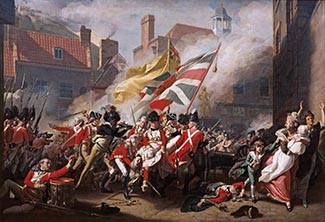
The same is true of more successful, better-known founders. In the case of Thomas Jefferson, should we see him as a slaveholder who played a pivotal role in allowing slavery and its racist legacy to endure? Or was he a gifted writer and politician whose words and actions helped make the Revolution’s democratic legacy available to all Americans, eventually including the descendants of the bondsmen and women who labored in his fields? For anyone who likes simple answers, the answer to both questions is a frustrating yes.
History is a messy business. So is the world today. As I look out over the students in my early American survey, I am reminded once again how important it is to teach the history of events like the American Revolution in ways that capture as much of its rich and challenging variety as we can. There are no guarantees, of course. There never are. If we succeed, however, we have at least a fighting chance of making the subject relevant for whatever it is they decide to do after they hand in their last assignment.
This essay appeared previously in slightly different form on the SHEAR (Society for Historians of the Early American Republic) blog The Panorama.
-
Written By:
Eliga Gould | UNH History Professor















































